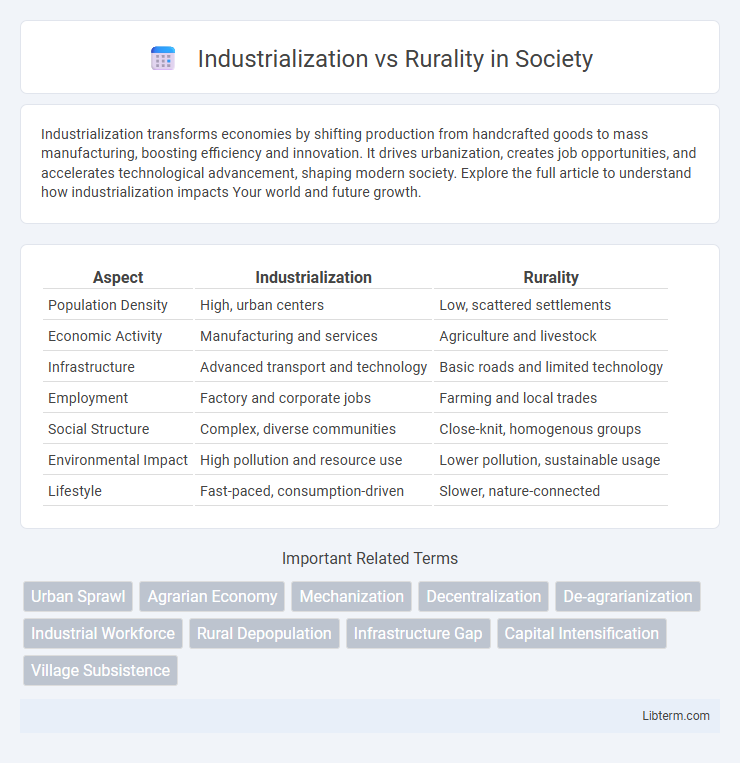Industrialization transforms economies by shifting production from handcrafted goods to mass manufacturing, boosting efficiency and innovation. It drives urbanization, creates job opportunities, and accelerates technological advancement, shaping modern society. Explore the full article to understand how industrialization impacts Your world and future growth.
Table of Comparison
| Aspect | Industrialization | Rurality |
|---|---|---|
| Population Density | High, urban centers | Low, scattered settlements |
| Economic Activity | Manufacturing and services | Agriculture and livestock |
| Infrastructure | Advanced transport and technology | Basic roads and limited technology |
| Employment | Factory and corporate jobs | Farming and local trades |
| Social Structure | Complex, diverse communities | Close-knit, homogenous groups |
| Environmental Impact | High pollution and resource use | Lower pollution, sustainable usage |
| Lifestyle | Fast-paced, consumption-driven | Slower, nature-connected |
Defining Industrialization and Rurality
Industrialization refers to the process of transforming economies from agrarian-based systems to ones dominated by manufacturing, advanced technology, and urban development. Rurality is defined by characteristics such as low population density, agricultural dependence, limited infrastructure, and a strong connection to natural landscapes. The contrast between industrialization and rurality highlights shifts in economic activities, population distribution, and lifestyle patterns.
Historical Context and Evolution
Industrialization transformed agrarian economies by introducing mechanized production and urban factory growth, leading to significant demographic shifts from rural to urban areas during the 18th and 19th centuries. Rurality, characterized by traditional agricultural practices and dispersed populations, faced decline as technological advancements and infrastructure development centralized economic activities in industrial hubs. The historical evolution reflects a transition from subsistence farming to mass industrial output, reshaping social structures, labor patterns, and settlement distributions worldwide.
Economic Impacts: Growth vs Sustainability
Industrialization drives rapid economic growth through increased manufacturing output, urban job creation, and technological innovation, significantly boosting GDP and export capacity. Rurality emphasizes sustainable economic practices by preserving natural resources, supporting local agriculture, and maintaining biodiversity, which ensures long-term environmental health and community resilience. Balancing industrial growth with rural sustainability is crucial to mitigating resource depletion, environmental degradation, and ensuring equitable economic development.
Social and Cultural Differences
Industrialization transforms social structures by fostering urbanization, increasing job specialization, and promoting diverse cultural interactions, which contrasts with rurality's reliance on agriculture, close-knit communities, and traditional cultural practices. Urban industrial centers tend to support secular values and fast-paced lifestyles, whereas rural areas emphasize communal bonds, heritage, and slower social rhythms. These social and cultural differences influence identity, family roles, and community engagement across industrial and rural contexts.
Technological Advancements and Accessibility
Technological advancements in industrialization have significantly improved manufacturing efficiency and urban infrastructure, leading to widespread economic growth and increased job opportunities. In contrast, rural areas often face limited access to technology and infrastructure, hindering agricultural productivity and access to essential services like healthcare and education. The disparity in technological accessibility between industrialized urban centers and rural communities continues to impact social and economic development.
Environmental Consequences
Industrialization significantly increases greenhouse gas emissions, air and water pollution due to concentrated factories and heavy machinery use, disrupting local ecosystems and biodiversity. Rurality, characterized by agricultural practices and lower population density, often results in land degradation and habitat loss but generally maintains better air and water quality. The environmental consequences of industrialization tend to be more severe and widespread, accelerating climate change and resource depletion compared to the localized impacts often found in rural areas.
Urban Migration and Demographic Shifts
Industrialization drives significant urban migration as rural populations relocate to cities in search of better employment opportunities and improved living standards. This demographic shift results in rapid urban growth, transforming city infrastructures and increasing demand for housing, transportation, and social services. Concurrently, rural areas experience population decline, aging communities, and changes in agricultural practices due to labor shortages.
Infrastructure and Quality of Life
Industrialization drives rapid development of infrastructure such as transportation networks, utilities, and communication systems, significantly enhancing urban quality of life through increased access to services and economic opportunities. In contrast, rural areas often experience slower infrastructure growth, leading to challenges in healthcare access, education, and connectivity that impact overall living standards. Investments in sustainable rural infrastructure can bridge this gap, improving quality of life and promoting balanced regional development.
Policy Approaches and Governance
Policy approaches to industrialization prioritize infrastructure development, investment incentives, and technological innovation to stimulate urban economic growth, whereas governance in rural areas emphasizes sustainable resource management, agricultural support, and community-based decision-making. Effective governance integrates participatory frameworks and decentralization to address disparities between industrialized urban centers and rural localities. Tailored policies promote balanced regional development by aligning industrial expansion with rural revitalization strategies.
Future Prospects and Sustainable Balance
Industrialization drives economic growth and urban development, yet poses challenges for rural communities by depleting natural resources and disrupting traditional livelihoods. Future prospects emphasize integrating advanced green technologies and smart infrastructure to foster sustainable, inclusive growth that benefits both urban and rural areas. Achieving a sustainable balance requires policies promoting rural innovation, renewable energy adoption, and equitable resource distribution to ensure long-term environmental health and social well-being.
Industrialization Infographic

 libterm.com
libterm.com